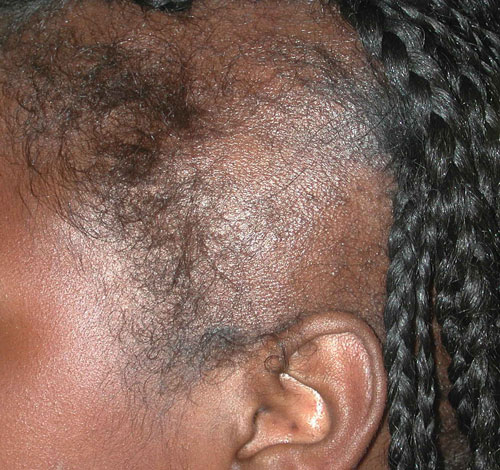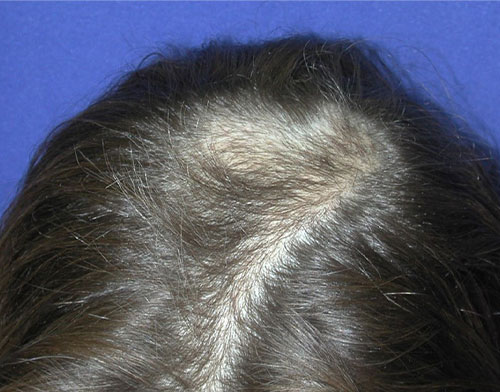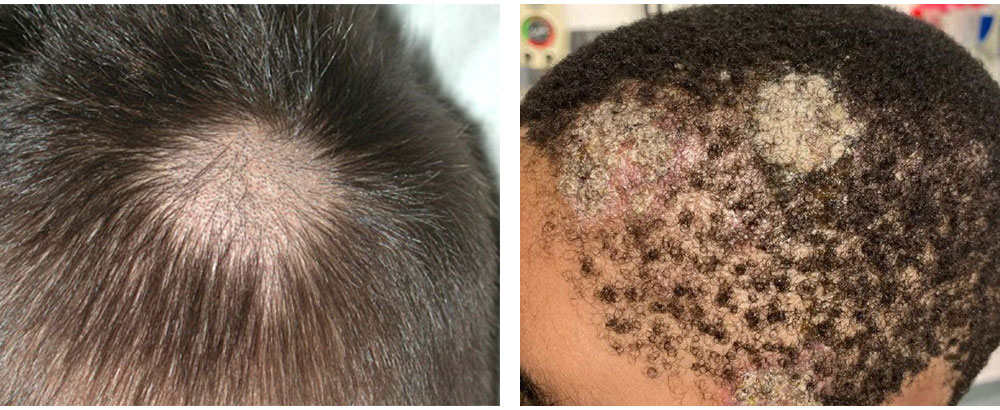By: Keri Wallace, MD, FAAP
Hair loss (alopecia) may not be as common in kids as adults, but there are variety of a reasons it may happen. While it can be upsetting for both parents and children, the condition usually improves once the cause is identified and addressed.
What causes hair loss in kids?
There are different causes of hair loss in infants, children and teens. The most common reasons depend on the child's age. In most cases, hair that is lost grows back on its own. There are treatments available when the hair is not growing back.
Is it normal for newborn babies to lose a lot of hair?
Hair loss is very common in
newborns and young babies. Almost all babies will have some (possibly all) of their hair fall out during the first few months of life. This is normal and to be expected—the hair will grow back!
Some babies will lose more hair on the back of their heads than other parts of the scalp. Don't worry—this is not unusual, and the hair grows back normally over a few months.
Common reasons for hair loss in older kids
Hair loss in older children can have a variety of causes. Some of the more common reasons a a child or teen may lose hair include:

|
|
Image: Traction alopecia |
Hair that is styled tightly (like in tight braids or frequent tight ponytails or buns) can cause hair loss, especially along the edges of the scalp at the front, sides and back. This condition is called
traction alopecia. It can get better by changing to looser hair styles. Avoiding caps and other things that constantly rub on the scalp can also help the hair grow back.
Stress. Physical stress (like high fever, hospitalization or surgery) or emotional stress (like a death in the family, a new school or a new home) may cause more hair to fall out than normal. This type of hair loss, called
telogen effluvium, can happen over a few weeks or months. The condition makes the hair seem thinner than it was before, but doesn't cause bald patches or complete loss of hair. Telogen effluvium hair loss gradually gets better on its own.

|
|
Image: Trichotillomania |
A child’s habit of twisting or pulling their hair, which is called
trichotillomania. Many children who develop this behavior often don't even realize they are doing it. Trichotillomania can cause the hair to break and fall out, leading to patches on the scalp with less hair than normal and broken off stubble hairs. Very young children tend to outgrow this habit. Older children and teens may benefit from
counseling and mental health care to break the habit.
-
A fungal infection can sometimes cause hair loss. "Ringworm" is a fairly common fungus infection of the skin or the hair. The medical terms for these infections are
tinea corporis and
tinea capitis. When this infection is on the scalp, the hairs break and fall out and the skin can look irritated and flaky. Treatment with an anti-fungus medicine given by mouth is necessary to clear this infection from the scalp.

Images: tinea infection
When bald spots are a sign of alopecia areata
Alopecia areata is an autoimmune disease that can affect people of any age, including children. It happens when the immune system, which is supposed to protect us and fight germs, instead attacks the hair follicles and causes hair to fall out.
What does alopecia areata look like?
Alopecia areata shows up as round or oval bald spots on the scalp with completely missing hair leaving smooth patches of skin. Most of the time, alopecia areata is limited to a few
patches, and the hair will regrow and fill in the patches.
Images: Alopecia areata
Treatment for alopecia areata
Treatments for alopecia areata can help when the hair doesn't regrow in a few months or a lot of the hair on the scalp is missing. The first step in treatment is with creams or ointments or lotions (such as steroid medicines) applied to the bald spots to decrease the immune system activity in those areas.
If the hair loss is widespread, it can be more difficult to treat. Luckily, new treatments are being studied all the time and some show good promise for more difficult alopecia areata.
When to see your pediatrician
Most newborns and very young infants will lose hair after birth, so there's usually no need to see a doctor beyond
regular checkups for this. However, discuss any ongoing hair loss that's affecting your child or teen with your pediatrician.
The doctor will look at your child's scalp and do a physical exam to help determine the cause of the hair loss. Sometimes bloodwork may be ordered and sent to a lab. For some children, a referral to a
pediatric dermatologist may be needed.
More information
About Dr. Wallace
 Keri Wallace, MD, FAAP is a board-certified pediatrician who has been a member of the American Academy of Pediatrics (AAP) since 2001. Dr. Wallace is a general academic pediatrician at Connecticut Children's Medical Center in the Primary Care Center and an Assistant Professor of Pediatrics for the University of Connecticut School of Medicine. Dr. Wallace has a special interest in pediatric dermatology and serves as a member on the Society of Pediatric Dermatology Education Committee and the AAP Section on Dermatology. Keri Wallace, MD, FAAP is a board-certified pediatrician who has been a member of the American Academy of Pediatrics (AAP) since 2001. Dr. Wallace is a general academic pediatrician at Connecticut Children's Medical Center in the Primary Care Center and an Assistant Professor of Pediatrics for the University of Connecticut School of Medicine. Dr. Wallace has a special interest in pediatric dermatology and serves as a member on the Society of Pediatric Dermatology Education Committee and the AAP Section on Dermatology.
Alopecia images courtesy Sarah Stein, MD, FAAD, FAAP
|